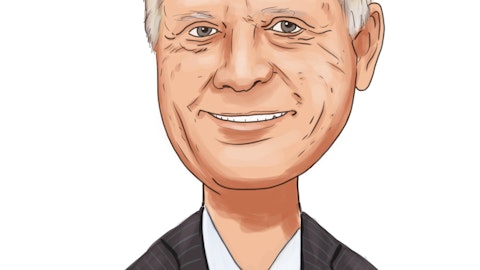These non-cash charges are adjusted out of our non-GAAP financial measures. Turning to other ferrous dynamics in the quarter. The share of domestic ferrous shipments was 48%. Our top sales destinations for ferrous exports were Bangladesh, Turkey, and India. Now, let’s move to Slide 12 for an update on non-ferrous sales and the market dynamics. Average net selling prices for copper, aluminum, and other non-ferrous products were down 7% sequentially, reflecting the decline in market prices since the spring. Lower generation of non-ferrous scrap also contributed to margin pressure. Prices of PGM metals continued to decline significantly with average net selling prices down 19% sequentially and almost 50% from a year ago, impacted by lower demand from the US and global auto industry.
Non-ferrous sales volumes remained at similar levels sequentially. We sold our non-ferrous products to 12 countries with the major export destinations being India, Malaysia, and China. Our product mix is highly diversified with sales of products recovered from shredding operations reaching around half of total non-ferrous volumes. Now, let’s move to Slide 13 to provide an update on our technology investments. We continue the deployment of our technology program focused on increasing metal recovery of non-tariff material, generating more furnace-ready higher-value products, and creating product optionality. We expect the remaining capital expenditures to complete these investments to be less than $5 million. Once fully operational, we expect these technologies to increase nonferrous volumes to recover from shredding of operations by at least 20%.
As shown in the slide our initiative comprises 13 systems in total. Of these, six are advanced separation systems all of which are now operational. We’re also implementing seven primary nonferrous systems for the recovery of aluminum and copper, which are the main drivers of the projected increase in recovery volumes and incremental profitability. During the quarter, we began commissioning on the West Coast of its primary recovery systems bringing to five the number of those that are either operational or in various stages of commissioning and ramp-up. There remain two major copper recovery systems to construct on the West Coast to complete our program. One of these systems continues to await permitting approval with construction on the order now projected to start by around the end of the calendar year.
As a result, we now target start of commissioning of these two remaining systems by the spring of 2024. The contribution to performance from these technologies in the fourth quarter was positive, but lower than the third quarter which had benefited from particularly supportive pricing for the nonferrous products we generated. The current weaker market conditions including a significant compression of the historical price premium between the higher-grade twitch aluminum product and Zorba all the way on the contribution from these systems. Now let’s move to slide 14 to discuss our steel mill performance. Demand for finished steel in the fourth quarter in our Western US market remained steady and reflected the lift from summer seasonality on construction activity.
Finished steel sales volumes reached 152,000 tons up 7% sequentially. Our mill operations reached full utilization significantly higher than the US average of 77% for the period. Average net selling prices for finished steel decreased 7% sequentially driven by lower raw material inputs and pressure from imports although down slightly sequentially metal spreads at our mill remained healthy historical comparison. As Tamara mentioned, we believe our mill stands to benefit from the expected demand created by the US infrastructure bill. Now let’s move to slide 15 and discuss cash flow, capital structure and our outlook for the first quarter. Operating cash flow in the fourth quarter was strongly positive at $135 million driven by EBITDA profitability and benefits to working capital including from the lower commodity price environment and collections from several ferrous bulk shipments that have been delayed at the end of the prior quarter.




